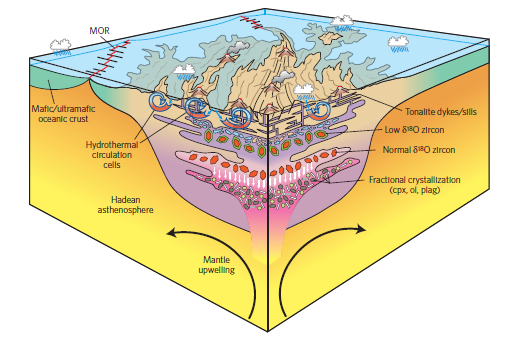Iceland tells us the secret of the earliest crust evolution
- Sangwoo Han
- Jun 10, 2017
- 2 min read
On the present Earth continents are everywhere, but the primeval Earth had almost none. The old earth surface was covered solely by vast ocean without any land. Modern mechanisms of continent growth are relatively well understood through numerous studies. The very first birth of continental materials, however, is still poorly understood, simply because most of the evidence has been obliterated through billions of years.
Magma, which is formed by partial melt of mantle rocks, ‘evolves’ and leaves behind minerals rich in magnesium, iron and calcium in the mantle. Accordingly, continental crust, a bulk of remnant evolved magma, is composed of silica-, alumina- and alkali-rich minerals; and thus is lighter than the other part of the solid earth. Therefore, in order to make continental crust, a thick solid layer is required, so that this layer enables a rising magma to evolve into ‘sialic’ composition. Two possible environments have been suggested: subduction zone and large igneous province (oceanic plateau).
Because geochemisty of Archean continental rocks (3.9~2.6 giga-years old, Gyr) match to that of sialic rocks from subduction zone environments, the continental crusts have been considered to form and grow at subduction zones.
But those researches on the ‘Archean rocks’ did not cover the most-‘archaic’ rocks: the Acasta Gneiss Complex (AGC), which is about 4.02 giga-year old. Nevertheless, conventional geochemical analysis are almost absent, because the AGC is generally subject to strong deformation and layerings.
This year, a breakthrough has been made for this rock complex. Reimink and his colleagues have found a fresh outcrop of AGC, whose deformation is such that it is worthy to apply geochemical analysis. Their analysis of AGC rocks revealed that the compositional properties of the AGC is considerably different from those of general Archean rocks. First, the AGC rocks is relatively Fe-rich, which indicates magma evolved at shallow depth. Plagioclase, a major crystallizing phase in low-pressure condition, accounts for the negative Eu anomaly in the rare-earth element patterns of the AGC, which is absent in those of the typical Archean rocks. Surprisingly, evolved rocks from Icleand, whose tectonic setting is an ocean plateau, share the same geochemical features of the AGCs.
Zircon, a strongly resistant mineral against post-magmatic overprinting, records the primary igneous environments of the rock. In the case of AGC rocks, primary zircon crystals survived, surrounded by overgrown metamorphic zircon rims. Two types of primary zircon grains are recognized: the earlier core without any oxygen-isotope disturbance and later mantle with plunged oxygen isotope ratios. The latter is attributed to hydrothermal alteration, implying possible early existence of surrounding hydrosphere, analogous to the modern Icelandic environment.
In this research, we can approach the new paradigm of the earliest continental crust occurrence, thereby comparing with iceland settings. More than 4 billion years ago, there were no continental crust at the most-archaic age. The earliest crustal rock is originated from the shallow depth magma penetrating into oceanic plateau. This process may be a crucial mechanism of the first birth of continental crust at early Earth development process, and perhaps it might have triggered the current plate tectonic movement.

그림 Schematic diagram illustrating the major processes responsible for the formation of the Acasta Gneiss Complex.
대표 논문)
Jesse R. et al., Earth’s earliest evolved crust generated in an Iceland-like setting, Nature geo, 2014.




















Comments